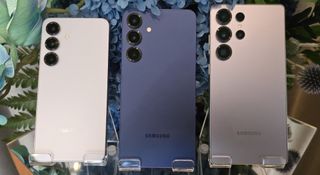Samsung Galaxy Phones

The Samsung Galaxy series is arguably the best-known line of phones after Apple's iPhones. That said, it encompasses more than just phones, with tablets, watches, earbuds and laptops all falling under the South Korean firm's Galaxy brand.
As far as smartphones go, the series is currently helmed by the Samsung Galaxy S smartphone series and the Samsung Galaxy Z foldable series, the company's most premium models.
Samsung's Galaxy phones run a gamut of price ranges, with the Galaxy A series firmly in budget territory, while the Galaxy S23 Ultra and Galaxy Z Fold 4 are as expensive as phones get.
Samsung usually refreshes its phones multiple times a year. The A-Series line will see multiple launches throughout the year as Samsung tries to hit multiple price points. On the flip side, the flagship lines, the Galaxy S and Z series, get a single annual refresh. The S series is typically the first and ends up being updated in the first few months of the year, normally around the Mobile World Congress in February or March. The Z series typically gets updated in August.
Explore Samsung Galaxy Phones
Latest about Samsung Galaxy Phones

A flurry of new Samsung Galaxy S26 Ultra leaks have arrived
By David Nield published
We've got some more advance information on the premium flagship from Samsung that's due in February.

Two new Samsung One UI 8.5 upgrades for Galaxy phones have leaked
By David Nield published
A major software update for Samsung phones is on the way, and we just got a preview of two of its new features.

Notable upgrades for the Galaxy Z Fold 8 and Galaxy Z Flip 8 are rumored
By David Nield published
The A new year means new foldables, and we might have learned some more about Samsung's next foldable phones.

I hope Android phones in 2026 fix Apple's biggest iPhone mistake
By Philip Berne published
The iPhone 16 Pro camera control was a flop, but Android makers have had enough time to cook up their own version — and I'm hoping it's great.

Will the Samsung Galaxy S25’s price drop when the S26 launches?
By James Rogerson published
The Samsung Galaxy S26 series is likely almost here, which could mean price drops for the Galaxy S25 line, but will that happen? And how much by?

New rumors point to a launch date and pricing for the Samsung Galaxy S26
By David Nield published
While the Galaxy S26 phones might be launching later in the year, it sounds as though they won't cost any more.

Check out leaked photos and videos of Samsung Galaxy S26 dummy units
By David Nield published
We've got some fresh leaks around the Galaxy S26 handsets, which are expected around February time.

The OnePlus 15 earned a perfect score; here’s how the Galaxy S26 Ultra could also be a five-out-of-five
By Philip Berne published
The next Ultra could be perfect if it does more with less
Sign up for breaking news, reviews, opinion, top tech deals, and more.

